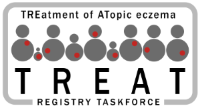What to measure
As a first step on our journey, we conducted an international eDelphi exercise and a consensus meeting among 410 dermatologists, nurses, non-clinical researchers involved in AE, pharmaceutical industry representatives, regulatory body representatives and patients from 36 countries, including members of the International Eczema Council (IEC), the European Taskforce for Atopic Dermatitis (ETFAD), and the International Society for Atopic Dermatitis (ISAD). The study identified a final core set containing 19 domains with 69 domain items to be captured by national AE systemic therapy registries (Gerbens et al., 2017; Gerbens et al., 2018).
Core set of domains and domain items
Minutes TREAT eDelphi Consensus Meeting Amsterdam 25th october 2016
How and when to measure
Further work has been performed to define how these 68 domains and domain items should be measured. Three round table consensus meetings have taken place in London (27th March 2017), Amsterdam (15th May 2017) and Nantes (12th June 2017). A consensus was reached for all domain items on how they should be measured by assigning measurement instruments. A minimum follow-up frequency of initially 4 weeks after commencing treatment, then every 3 months while on treatment and every 6 months while off treatment was defined (Vermeulen et al., 2019).
TREAT survey
This short web-based survey aimed to provide insight into current prescribing practices of photo- and systemic immunomodulatory therapies in Europe for adults with moderate-to-severe AE and the factors influencing these prescribing practices (Vermeulen et al., 2020). The survey complements our previous European and North American surveys (Proudfoot et al., 2013; Taylor et al., 2016; Totri et al., 2017).
TREAT national registries
See Spuls et al., 2017. Several national registries are currently ongoing or in the development phase. The best-practice guidelines of the European Commission funded PAtient REgistries iNiTiative joint action (PARENT JA) is taken into account (Zaletel and Kralj, 2015).
Eligible patients are children and adults diagnosed with AE who are starting on photo- or systemic immuno-modulatory therapy (conventional immunomodulatory therapies as well as new biologics and small molecules), taking into account the national and local eligibility criteria for these specific therapies. Patients will be followed independently of stopping therapy or subsequent switch to other therapies.
The protocol of the registry has been published, see Bosma et al., 2019.
Atopic eczema and COVID-19
Past years we have run an international COVID-19, secure, online, de-identified Personal Health Identifier (PHI)-free reporting registry: the Surveillance Epidemiology of Coronavirus Under Research Exclusion (SECURE)-AD registry (Musters et al., 2023). COVID-19 outcomes in AE patients treated with and without systemic immunomodulating medication were gathered, to answer questions regarding how COVID-19 might impact patients with AE who are treated with systemic immunomodulating medication.
The SECURE-AD registry was supported by the International Society for Atopic Dermatitis (ISAD), the International League of Dermatological Societies (ILDS), the European Task Force on Atopic Dermatitis (ETFAD), the European Dermato-Epidemiology Network (EDEN), the European Dermatology Forum (EDF) and the Skin Inflammation and Psoriasis International Network (SPIN).
Mapping exercise
To examine the degree of overlap and pooling ability between the national registry datasets, we performed a mapping exercise (Musters et al., 2023). Further an overview of the status and characteristics of the eight established TREAT registries was given. The exercise showed that pooled analyses across all registries can be performed on multiple important domain items, covering the main aims of analysing data on the (cost-)effectiveness and safety of AE therapies.
Baseline paper
This study provides a comprehensive overview of the demographics, prior systemic treatments, clinical characteristics, and disease severity and burden at baseline among patients enrolled in seven TREAT registries (Musters et al., under review). Moreover, tthe current prescribing practices of various therapies for patients with AE across Europe are explored.
DREAM TO TREAT AD
This investigator-led, funded by Pfizer study was set up to collect real-world data on abrocitinib use in AE as well as conventional systemic treatments, with the aim to describe treatment (prescription) patterns as well as treatment effectiveness within a three-year follow-up period in five European AE registries: Germany (TREATgermany), the Netherlands and Belgium (TREAT NL/BE), Denmark (SCRATCH), Ireland (A-STAR Ireland), and the United Kingdom (A-STAR UK). Several papers are in preparation.
Pregnancy
The effect of targeted therapy during pregnancy on maternal and fetal outcomes, and during lactation on the baby will be researched upcoming years by the registries. Extra questions will be added to the dataset.
